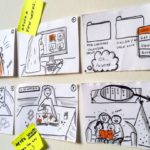Storyboarding
Storyboarding builds a sequential narrative of the user’s interaction with your product. It is useful in several stages of the product development process:
- Early phases – Making early ideas concrete and helps with the feature articulation.
- Later phases – Provides a reality check of the interactions, coherence, and flow.
- Throughout – it also can act as an alignment tool and also surfaces important parts of the experience that lie outside the
- Product Interaction – Partnerships or other accommodations may be needed to support these.
Detailed steps
1. DEFINE
What you want your focus to be. Either on a problem, or a set of ideas.
2. PLAN
Give people time to think individually about the idea and how a experience could work. Think about the beginning, middle, and end of the experience and translate it into, for your idea what is the problem a user would be solving, how would they seek out a solution and how would they use your solution. Mind mapping and loads of post its can be useful at this stage.. This should take about 5-10 min each and be done alone.
3. CREATE
Give each person a sheet of A4 white paper and fold it across and then three times vertically to create 6 boxes (or just draw them). Give each person a pen and ask them to draw out how they think the idea being considered should work. his is not about high fidelity or being an artist, everyone can join in.
4. SHARE
Ask everyone to hang their storyboards on the wall and share their ideas. When things are clarified, capture them on post its and add to the boards. This joint review will help identify problems and clarify areas of confusion prior to development.
5. PRIORITIZE
Give everyone 2-3 small stickers and ask them to vote for their favorite board and/or pieces of the experience that they like. One of the key benefits of storyboards is that we can make better informed decisions because the idea is represented by a holistic,end-to-end, visual articulation.
6. CONSOLIDATE
Pin the top voted boards up on a wall surface. Discuss the boards in the group (ask questions like: what was important? why was it important? how do the fit together?). Use the wall space to consolidate the best ideas and sections into a single, best-in-class storyboard.


 Previous Post
Previous Post Next Post
Next Post